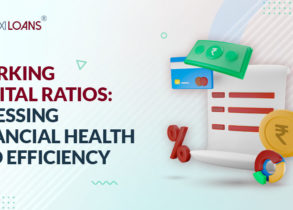Aug 09, 2023
Nov 28, 2025

Overview:
Working capital is like the energy that keeps a company running every day. The working capital formula includes the money needed to keep everything moving. Think of it as a balance between what a business owns and what it owes right now. A company facing a shortage of working capital may seek help from investment bankers. It may secure a business loan from a financial institution.
Current assets are a big part of this balance. They work like a financial safety net for businesses. They help companies manage sudden expenses, seize opportunities, and ensure smooth operations. Let’s focus on the key component of the working capital formula: “current assets.”
What are Current Assets?
Current assets are the assets that you can convert into cash within a year. This could be because you sell them, use them up, or they are part of your regular business operations. Think about the products you have in your store that you will sell soon or the money that your customers owe you. These are all current assets.
To understand how your business is doing, you look at something called the balance sheet. It’s like a financial photo that shows what you have (your assets) and how you got them (using loans or your own money). The balance sheet covers a specific time, usually a year.
On this balance sheet, is where you can locate your current assets right at the top. Why? Because they are the most liquid assets. We arrange these assets in a specific order, making it easier to turn them into cash when needed. This arrangement helps keep things organised. So, the more liquid the asset, the higher up on the list it goes.
What Can You Do with Current Assets?
Current assets are like your business’s handy toolkit. You need them to keep things moving. Here’s what you can do with these assets:
- To Run Day to Day Operations:
- You have got inventory to stock your shelves and make sure customers find what they want.
- Paying employees is necessary.
- To Invest in Your Business’s Future:
- Upgrading your equipment or getting a new office space.
- To Stay on Top of Bills and Loans:
- To cover debt payments on time.
Types of Current Assets:
Let us take a look at the variety of current assets at hand:
- Cash:
Cash is a main asset, at the top of your balance sheet. It includes local and foreign money. It also includes business checking accounts, payments, customer receipts, and on-hand cash. - Cash Equivalents:
Cash equivalents are not as liquid as cash itself. These assets stand as liquid reserves, convertible to cash at a moment’s notice. It includes marketable securities, short-term government bonds, treasury bills, and money market funds. - Accounts receivable:
Accounts receivable consist of customer debts to your business. These dues usually transform into cash within a year. So, they’re tagged as current assets. Let’s say your interior company crafts a custom cupboard. And, the payment is pending upon delivery. This owed sum finds its place in accounts receivable.
If a good or service’s conversion to cash extends beyond a year, it shifts into the long-term asset realm. Then, it departs from current assets.
- Inventory:
Inventory blankets your raw materials and unsold merchandise. This encompasses items that generally sell within a year. Prudent inventory management is important. Overstocking risks obsolescence or expiry, especially for perishable goods. On the flip side, understocking translates to missed sales and irked customers. - Prepaid expenses:
Prepaid expenses see their spot on the balance sheet, led by prepaid insurance. This category embodies upfront insurance payments. Insurance premiums precede the coverage period and companies settle them within a year. Rent, too, can strut its stuff as a current asset. Paying rent ahead of schedule earmarks it as prepaid rent.
How to Calculate Current Assets?
Lay out your current assets on the balance sheet. Then, computing your total current assets is a breeze. Sum up all these elements.
Current Assets for Working Capital Formula:
Current assets help balance sheet analysis by calculating liquidity ratios. Ratios show asset-liability balance and financial health. Insights into fiscal well-being and capacity for financial commitments. Let’s take a look at a few familiar forms of liquidity ratios:
| Ratio | Description | Formula |
| Current Ratio | Evaluates the proportion of current assets to current liabilities within a year. | Current Ratio = Current Assets / Current Liabilities |
| Quick Ratio | Assesses the capability to meet short-term financial obligations using liquid assets. | Quick Ratio = (Cash + Cash Equivalents + Marketable Securities + Accounts Receivable) / (Short-term Debt + Accounts Payable + Accrued Liabilities and Other Debts) |
| Net Working Capital | Provides insight into current liquidity, financial health, and efficiency. | Net Working Capital = Current Assets – Current Liabilities |
FlexiLoans’ Working Capital Loans:
FlexiLoans cater to the financing needs of small and medium-sized enterprises (SMEs). It addresses the challenges they often encounter when seeking small business loans.
The advantages of opting for FlexiLoans Working Capital Loans are large:
- Faster Processing: You can avail a working capital loan in three days. But, you must provide the fulfilled paperwork.
- Ownership Retention: Quick and collateral-free access to credit.
- Cash Flow Enhancement: operational continuity despite cash reserve shortages and fluctuations in sales.
- Credit Score Improvement: There are some who can’t meet bank loans due to low credit scores. Flexiloans provides a chance to enhance credit scores. It reports business loan transactions to the Credit Bureau.
SMEs can thrive with FlexiLoans. They can overcome the hurdles that often hinder their growth. At Flexiloans we offer MSME Loans, Term Loan, Business Loan for Women, and to many more industries. Visit the Flexiloans website, today!
FAQs
Current assets are short-term. They can turn into cash within a year or cycle. Non-current assets are long-term, beyond a year or cycle.
Current assets include cash, accounts receivable, and inventory. Current liabilities encompass accounts payable, taxes, wages, and owed interest. Working capital arises from the difference between current assets and liabilities.
Working capital is also known as net working capital. The company considers capital for operations as circulating. It includes cash, expenses, materials, inventory, and receivables.
Deprecated: Function get_the_author was called with an argument that is deprecated since version 2.1.0 with no alternative available. in /var/www/html/wordpress/flexiloans.com/blog/wp-includes/functions.php on line 6114
Deprecated: Function get_the_author was called with an argument that is deprecated since version 2.1.0 with no alternative available. in /var/www/html/wordpress/flexiloans.com/blog/wp-includes/functions.php on line 6114







